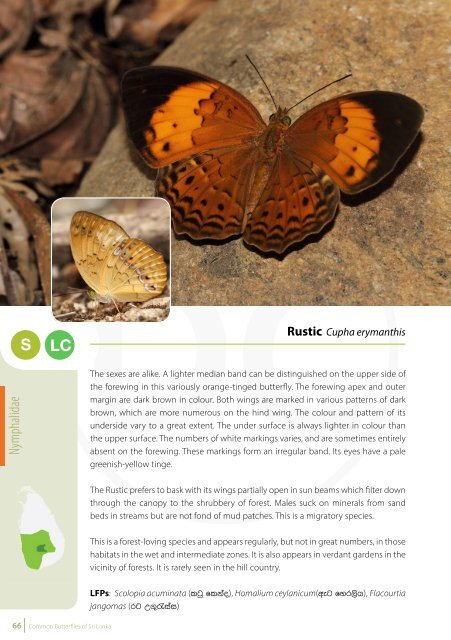Common Butterflies of Sri Lanka
Common Butterflies of Sri Lanka
Common Butterflies of Sri Lanka
You also want an ePaper? Increase the reach of your titles
YUMPU automatically turns print PDFs into web optimized ePapers that Google loves.
S<br />
LC<br />
Rustic Cupha erymanthis<br />
Leopard Phalanta phalantha<br />
S<br />
LC<br />
Nymphalidae<br />
The sexes are alike. A lighter median band can be distinguished on the upper side <strong>of</strong><br />
the forewing in this variously orange-tinged butterfly. The forewing apex and outer<br />
margin are dark brown in colour. Both wings are marked in various patterns <strong>of</strong> dark<br />
brown, which are more numerous on the hind wing. The colour and pattern <strong>of</strong> its<br />
underside vary to a great extent. The under surface is always lighter in colour than<br />
the upper surface. The numbers <strong>of</strong> white markings varies, and are sometimes entirely<br />
absent on the forewing. These markings form an irregular band. Its eyes have a pale<br />
greenish-yellow tinge.<br />
The Rustic prefers to bask with its wings partially open in sun beams which filter down<br />
through the canopy to the shrubbery <strong>of</strong> forest. Males suck on minerals from sand<br />
beds in streams but are not fond <strong>of</strong> mud patches. This is a migratory species.<br />
This is a forest-loving species and appears regularly, but not in great numbers, in those<br />
habitats in the wet and intermediate zones. It is also appears in verdant gardens in the<br />
vicinity <strong>of</strong> forests. It is rarely seen in the hill country.<br />
The sexes are alike. The background colour <strong>of</strong> its upper surface is uniformly orange and<br />
variously marked in dark brown patches and streaks which are scattered throughout<br />
the wings. The outer margins and forewing apex are not entirely coloured in dark<br />
brown. The colour and pattern <strong>of</strong> the underside vary. The background colour takes on<br />
various shades <strong>of</strong> pale orange, with a purplish tinge apparent in some newly emerged<br />
individuals. Some individuals also have a median band <strong>of</strong> diffused white patches on<br />
the hind wing. Its eyes are grey coloured.<br />
Both sexes <strong>of</strong> the Leopard are frequently seen busily flying around its larval food<br />
plants. Females are more sedentary and hang around these plants due to the ease <strong>of</strong><br />
access to lay eggs. Males come to these trees in search <strong>of</strong> mates. During these visits,<br />
males are able to even mate with newly-emerged females who are not yet ready to fly.<br />
Males also gather on the wet soil <strong>of</strong> sand beds. This is a migrant species.<br />
This butterfly can be found in sparsely wooded gardens and scrublands. It is common<br />
throughout the island, becoming scarce towards the highest hills.<br />
Nymphalidae<br />
LFPs: Scolopia acuminata (lgq flkao), Homalium ceylanicum(weg fyr,sh), Flacourtia<br />
jangomas (rg W.=/iai)<br />
LFPs: Salicaceae plants including Flacourtia indica (W.=/iai), Flacourtia jangomas (rg<br />
W.=/iai), Dovyalis hebecarpa (legô,a,)<br />
66 <strong>Common</strong> <strong>Butterflies</strong> <strong>of</strong> <strong>Sri</strong> <strong>Lanka</strong><br />
<strong>Common</strong> <strong>Butterflies</strong> <strong>of</strong> <strong>Sri</strong> <strong>Lanka</strong> 67















